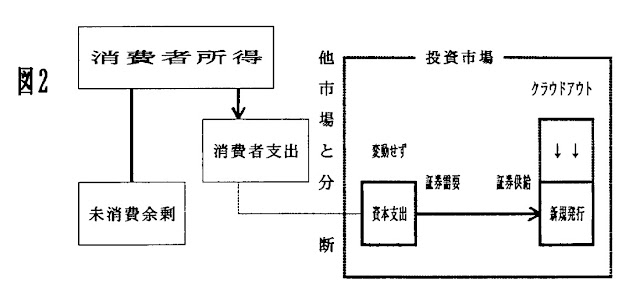ケンブリッジのキャッシュバランス式アプローチ
サイモン・
ニューカムとアーヴィング・
フィッシャーの
貨幣数量説は、すでに見たように、お金が安定した交易需要を持つという発想に完全に依存している。これは、お金が交換媒体としてだけ需要され、それが制度的に強制されているんだ、というのが前提となる。この点を修正したのが、20 世紀前半の
ケンブリッジの経済学者数名だ。特に A.C.
ピグー (1917)、アルフレッド・
マーシャル (1923), D.H.
ロバートソン (1922)、ジョン・メイナード・
ケインズ (1923), R.G.
ホートリー、フレデリック・
ラヴィントン (1921, 1922) が挙げられる。かれらが共同で作り出したのが、その後「ケンブリッジのキャッシュバランス」アプローチと呼ばれるようになったものだ。
かれらの掲げた説は、お金は価値を貯める手段として求められるんだ、というものだ。だからケンブリッジ派の言い分は、フィッシャーの言い分とは根本的にちがってる。フィッシャーだと、お金はそれがたまたま交換媒体となっているから、エージェントたちにある一定額が求められるというだけの話だ。フィッシャーが書いているように、お金は持ち主に何の利益ももたらさない。でもケンブリッジ説だと、そんなことはないのだ。お金はある面で本当に効用を高める。つまり販売と購入を分離できるようにしてくれるのと、不確実性に対するヘッジとしてだ。
その理由は、アダム・
スミスや W.S.
ジェヴォンス (1875)、カール・
メンガー (1892) が述べた概略と同じだ――お金というのは、取引コストや求めるものの一致問題(訳注:物々交換の世界だと、たまたま自分の望む取引をしたがる人――たとえば、手元のリンゴを乾電池と交換してくれる人はいないかな、とか――が都合良くそこらに居合わせる可能性はほとんどないので、とっても不便だよ、というお話)をなんとかするのに必要だ、というわけね。かれらが述べているように、同時の多者間取引が、取引コストなしで行えるんなら、交易者たちがお金を必要とするかどうかは必ずしもわからん。お金のいいところというのは、それが偶然同じものを交換したがっている人を見つけなくていい、ということだ。エージェントはある一時点で自分の商品を「お金」と交換に売れる。そして一番いい値段をゆっくり探して、それからその「お金」を最終的に欲しいモノと交換すればいい。
ケンブリッジ派の教えは、商品の販売と購入は同時じゃないので、購買力を「一時的に寝かしておく場所」が必要だ、ということだった。富の一時的な保管場所ですな。特に A.C.
ピグー (1917) は、お金の需要が予防的な動機を含む場合も含めた――お金を持つのは、不確実な状況のためのヘッジとして機能するわけね。
この富の保管と予防的なモードの場合、お金が消費者に対して効用をもたらす。だからある意味で、お金はそれ自体が欲求されるものとなる。いくらくらいが求められるのかは、一部は所得によるし、また一部は他の条件、特に富や金利による。最初の部分はもちろん取引条件の中に組み込まれている。所得が高いほど、購買や販売の量も多くなるし、だから取引コストを克服するための一時的避難所としてのお金に対するニーズも高くなる。だからケンブリッジ理論家たちは、実質的なお金の需要を、実質所得の関数として考えた。つまり:
M / P = kY
ここで k は有名な「ケンブリッジ定数」だ。でもこれはずいぶん誤解のものだ。というのも「定数」の k はちっとも一定なんかじゃないからだ。むしろそれは、他の要素、たとえば金利(お金の機会費用)や富に左右される。
これをフィッシャーの体系と比べるには、実質所得 (Y) と取引 (T) は均衡下では等しくなる、ということさえわかればいい。もちろん、富の取引の中には厳密には所得にも産出にも含まれないものがある (たとえば家みたいな既存資産の販売)。これは単に所有権の移転でしかないからだ。これを回避するには、
ピグー (1927) が書いているように、家の適正な販売価値というのは実は賃料の割引現在価値なんだ、というのを認識すればいい (賃料は所得になる)。だから富の取引は、割引かれた所得ストリームの取引をあらわしている。というわけで、少なくとも長期の完全な世界なら、 T = Y になると言える。だからフィッシャーの方程式は M/P = (1/V)Y とあらわせる。ここで k = 1/V だ。
ということで、この二つの式は、相互に導けるものだ。でもその理論はかなりちがっている。まず、ここでのお金は価値の保存、不確実性からくる効用をもたらす形で書かれている。フィッシャーでは、取引を可能にする制度的な交換媒体でしかなかった。第二に、ケンブリッジ派は k (ひいては V) が必ずしも制度的に固定されておらず、むしろ変化するという発想を提示した。
でも、リアル部門(実体経済)と金融部門との二律背反は、k に何が含まれているか曖昧だ、というのを考えると、破られているとは言い難い。そしてこれを考案した人たちも、この点をあまり突き詰めたがらなかった (
Patinkin, 1974 を参照)。何より、ケンブリッジ派は不確実性と安心が k に入り込んで、リアル経済の上下動が起きるという問題を考えた――これはすでに
マーシャル (1890: 591-2) にもある発想だ。でも、この説明は白黒をはっきりさせる力を持っていなかった。なぜかというと、そうした状況での期待形成について、何の理論も提示しなかったからだ――だから経済の上下動の理論としては、それは(どんなに引き延ばされても)短期の現象でしかなかった。でもこんな理論はおもしろくもなんともない。実際、
フィッシャー (1911) の信用サイクル理論と「ドルのダンス」によって、短期的な調整コストがあると数量説が成り立たないことが示されてしまったので、なおさらだ。でも、ケンブリッジアプローチの主要論点は以下の二点にまとめられる: (1) 中立性は成り立つけれど、リアルと金融の二律背反はアヤシイ; (2) お金はサービスを生み出すもので、だから選好される。
アルフレッド・
マーシャルの一番弟子にして後継者だったアーサー・セシル・ピグーは、「
ケンブリッジの新古典派」を体現する人物だった―― 20 世紀最初の 1/3 における正統マーシャル派の中核的な存在だ。かれの名声の相当部分は
Wealth and Welfare (1912, 1920) によるもので、ここでかれは社会福祉を経済分析の範疇に含めた。ピグーは特に、私的な限界生産や費用と、社会的な限界生産や費用を区別したことで有名であり、また政府が税や補助金の組み合わせによってそうした市場の失敗を矯正できる――あるいは「外部性を内部化できる」――という発想でも知られる。
でもピグーはあまり運のいい人じゃなかった。かれのアプローチはすぐに、
ロビンスや
ナイトからのものすごい批判にさらされた。1930 年代後半に登場した「
新厚生経済学」は、ピグーの分析ツールをほとんど無視した。後に
公共選択理論家たちは、ピグーのアプローチがナイーブな「優しい独裁者」的想定を使っているということで攻撃。そして最後に
コースが、財産権さえしっかり割り振られていれば、そんなのはどうでもいいことを実証してしまった。
もう一つの不運の源は、ピグーがジョン・メイナード・
ケインズによってボケ役に使われてしまったことだった。『一般理論』の中で、ケインズはピグーの
Theory of Unemployment (1933) を名指しで
新古典派マクロ経済学のダメなところのすばらしい見本として挙げた。ピグーは、かつての同僚にして友人に裏切られたショックから回復することはなかった。ピグーの余生は、たまに反撃したり (たとえば「
ピグー効果」(1943 1947))、
ケインズ革命に降伏したり (たとえば 1945, 1951) することで費やされた。
アーサー・C・ピグーの主要著作
- Robert Browning as a Religious Teacher, 1901.
- Tariffs, 1903.
- "Monopoly and Consumers' Surplus", 1904, EJ
- Industrial Peace, 1905.
- Import Duties, 1906.
- "Review of the Fifth Edition of Marshall's Principles of Economics", 1907, EJ
- "Producers' and Consumers' Surplus", 1910, EJ.
- Wealth and Welfare, 1912.
- Unemployment, 1914.
- "The Value of Money", 1917, QJE.
- The Economics of Welfare, 1920.
- "Empty Economic Boxes: A reply", 1922, EJ.
- The Political Economy of War, 1922
- "Exchange Value of Legal Tender Money", 1922, Essays in Applied Economics
- Essays in Applied Economics, 1923.
- Industrial Fluctuations, 1927.
- "The Law of Diminishing and Increasing Cost", 1927, EJ.
- A Study in Public Finance, 1928
- "An Analysis of Supply", 1928, EJ.
- The Theory of Unemployment, 1933.
- The Economics of Stationary States, 1935.
- "Mr. J.M. Keynes's General Theory", 1936, Economica
- "Real and Money Wage Rates in Relation to Unemployment", 1937, EJ.
- "money Wages in Relation to Unemployment, 1938, EJ
- Employment and Equilibrium, 1941.
- "The Classical Stationary State", 1943, EJ.
- Lapses from Full Employment, 1944.
- "Economic Progress in a Stable Environment", 1947, Economica
- The Veil of Money, 1949.
- Keynes's General Theory: A retrospective view, 1951.
- Essays in Economics, 1952.
A.C. ピグーに関するリソース









富国と強兵#13より
…バランスシ ートの資産面 、すなわち銀行貸出が生産活動に与える影響にまで考察を及ぼしたのは 、ホ ートレ ーであった ★ 3 3 。
我々は 、アダム ・スミスによる富の生産と獲得の個人的自由の想定ではなく 、ホ ートレ ーによる富の生産と引き渡しの義務の想定から経済理論を始める 。 (中略 )スミスにおいては 、信用の理論と生産の理論は完全に分離していた 。というのも 、生産は交換価値のみを創造し 、信用は別のスト ーリ ーを起点にしていたからだ 。しかし 、ホ ートレ ーにおいては 、生産の理論は 、同時に生産と信用の理論である 。というのも生産は 、商品を得る者には負債を 、商品を引き渡す者には同等の信用を創造するからである ★ 3 4 。
生産と信用を結びつけたホ ートレ ーの議論とは 、要すれば 、次のようなものである 。商人が生産者に商品の注文を出すと 、生産者は商品の生産に必要な費用 (原材料費と人件費 )を 、銀行から借り入れる (この時 、預金が同時に創造される ) 。生産者は 、生産を行い 、原材料費と賃金を支払う 。生産者は 、商人に商品を引き渡し 、商人はその代金を支払うために銀行から借り入れる 。生産者は支払われた貨幣を銀行への返済に充てる 。商人は商品を消費者に販売し 、消費者は労働者として受け取った賃金の内から代金の支払いを行う 。商人は受け取った代金を銀行への返済に充てる 。銀行への返済によって 、預金は消滅する 。 「消費者の購買力は 、商人が銀行から借り入れる信用から主に供給されている 。信用は生産から生じ 、消費において消滅する ★ 3 5 。 」
★ 3 3 C o m m o n s ( 1 9 9 0 : V o l . 1 , p . 4 7 2 ) ;古川顕 『 R ・ G ・ホ ートレ ーの経済学 』ナカニシヤ出版 、 2 0 1 2年 、 p . 2 8 。
★ 3 4 C o m m o n s ( 1 9 9 0 : V o l . 1 , p p . 4 7 3 4 7 4 )
★ 3 5 R . G . H a w t r e y , C u r r e n c y a n d C r e d i t , L o n g m a n s , G r e e n a n d C o . , 1 9 1 9 , p . 1 0 .
J o h n R . C o m m o n s , I n s t i t u t i o n a l E c o n o m i c s : I t s P l a c e i n P o l i t i c a l E c o n o m y , V o l . 1 , T r a n s a c t i o n P u b l i s h e r s , 1 9 9 0 , p . 5 8 .